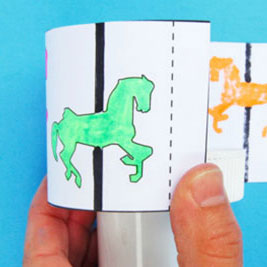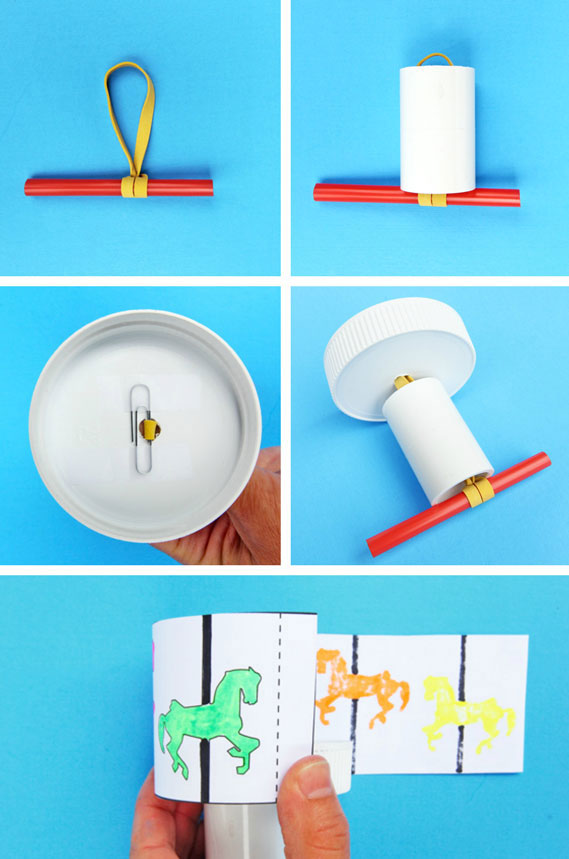 Image from PBS Kids for Parents.
Image from PBS Kids for Parents.
Energy Carousel
- Moderate
- Not Messy
- 30 Minutes
- Indoor
Take a spin!
Have you ever ridden on a carousel or merry-go-round at an amusement park? Usually, these rides are powered by electricity, but you can make your own carousel toy while exploring some basic energy concepts.
You Will Need
Paper
Markers
Scissors
Plastic Lid – about 3″ diameter (peanut butter jar lids work well)
Wide Rubber Band (thin rubber bands won’t work!)
Paper Clip
Clear Tape
Plastic Straw, cut to 3 ½” length
Glue
2″ long Plastic Tube (a 1″ diameter PVC coupling from the hardware store works well!)
Drill & Drill Bit (adults only)
Don't Have Plastic Tubing? Try repurposing:
- An extra-wide Straw cut down to 2”
- An empty Tube of Lip Balm, center removed.
Note:
- You must use plastic tubing. Paper tubing (i.e. paper towel rolls) will create too much friction with the plastic lid. It’s also important to make sure your tube is wide enough for the rubber band to twist and unwind inside
Directions
- Ask your scientist a few questions about energy. Can they think of an example of when energy is stored? (maybe a battery or a gas tank in a car) Can they think of an example of when energy is in motion? (a car driving, a person dancing, a light shining, etc.)
- Print the template on plain paper or cardstock. Ask your scientist to color the carousel and top as desired.
- If your scientist has good cutting skills, ask them to cut the paper template along the bold lines.
- Show your young scientists how to fold the template along the dashed lines and set these pieces aside.
- ADULT STEP: Drill a ¼” diameter hole through the center of the plastic lid. If you don’t have a drill bit that large you can rotate the drill slowly as you make the hole to enlarge it.
- Work together to thread the straw through the rubber band and knot. Pull the loose end of the rubber band through the plastic tube. (If using a narrow tube, push the band through the tube using a toothpick.)
- Work together to thread the rubber band through the hole in the bottom of the lid. Thread a paper clip through the rubber band, and tape the clip to the inside of the lid.
- Wrap the carousel template around the plastic lid. Tape the paper together to form a circle, then tape the lower part of the template to the bottom of the lid.
- Add the paper top to the carousel and secure in place with glue. Let dry.
- After the glue has dried completely, show your scientist how to hold the center tube and the carousel top with one hand. With the other hand, wind up the toy by twisting the straw and rubber band. (If your scientist can’t hold both the center tube and the carousel with one hand, offer to hold it for them while they wind up the straw.) Let go of the carousel. What happens next? Where did it get the energy? (It should spin quickly! Wind it up and spin again!)
 Image from PBS Kids for Parents.
Image from PBS Kids for Parents.
Troubleshooting tips:
- Make sure the rubber band is able to unwind. If your plastic tube is too small, the rubber band will get knotted up inside and be unable to twist.
- Sometimes you can wind up the rubber band too much, making it knotted and unable to unwind. In this instance flip the carousel over, let it unwind completely, then try winding it again.
- After a lot of winding, the rubber band may begin to tear. If this happens, replace the rubber band.
Experiment Extensions
- Experiment with different materials for the plastic tube. By varying the tube you will be able to see which materials and shapes work and which don’t. Try substituting a paper towel tube cut down to 2 inches. (You’ll likely find that the paper tube and plastic lid create too much friction when they are in contact, and the carousel spins very slowly.)
- Color the top with two primary colors. When the carousel spins, ask your scientist to watch closely to see if the colors combine for a moment into a secondary color!
How it works
Kinetic Carousels demonstrate two types of energy: potential energy and kinetic energy.
Potential Energy is stored energy. When the rubber band is tightly wound it has a lot of energy, but until you let go, the energy is stored up waiting to be unleashed; we call this potential energy.
Kinetic energy is the energy of an object in motion. Once you release the top of the carousel, the rubber bands unwind quickly; this movement is kinetic energy.
Key Words
- Potential Energy
- Stored energy
- Kinetic Energy
- The energy of an object in motion
